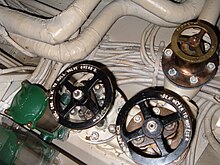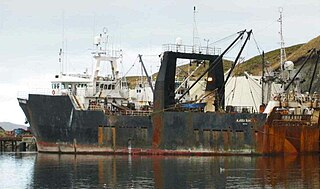A torpedo tube is a cylindrical device for launching torpedoes.
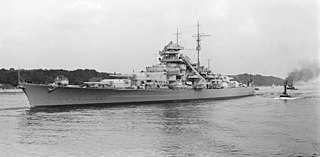
Bismarck was the first of two Bismarck-class battleships built for Nazi Germany's Kriegsmarine. Named after Chancellor Otto von Bismarck, the ship was laid down at the Blohm & Voss shipyard in Hamburg in July 1936 and launched in February 1939. Work was completed in August 1940, when she was commissioned into the German fleet. Bismarck and her sister ship Tirpitz were the largest battleships ever built by Germany, and two of the largest built by any European power.

Scapa Flow is a body of water in the Orkney Islands, Scotland, sheltered by the islands of Mainland, Graemsay, Burray, South Ronaldsay and Hoy. Its sheltered waters have played an important role in travel, trade and conflict throughout the centuries. Vikings anchored their longships in Scapa Flow more than a thousand years ago. It was the United Kingdom's chief naval base during the First and Second World wars, but the facility was closed in 1956.

A dry dock is a narrow basin or vessel that can be flooded to allow a load to be floated in, then drained to allow that load to come to rest on a dry platform. Dry docks are used for the construction, maintenance, and repair of ships, boats, and other watercraft.

HMS Audacious was the fourth and last King George V-class dreadnought battleship built for the Royal Navy in the early 1910s. After completion in 1913, she spent her brief career assigned to the Home and Grand Fleets. The ship was sunk by a German naval mine off the northern coast of County Donegal, Ireland, early during the First World War. Audacious slowly flooded, allowing all of her crew to be rescued and finally sank after the British were unable to tow her to shore. However, a petty officer on a nearby cruiser was killed by shrapnel when Audacious subsequently exploded. Even though American tourists aboard one of the rescuing ships photographed and filmed the sinking battleship, the Admiralty embargoed news of her loss in Britain to prevent the Germans from taking advantage of the weakened Grand Fleet. She is the largest warship ever sunk by naval mines.

The Hiram M. Chittenden Locks, or Ballard Locks, is a complex of locks at the west end of Salmon Bay in Seattle, Washington's Lake Washington Ship Canal, between the neighborhoods of Ballard to the north and Magnolia to the south.
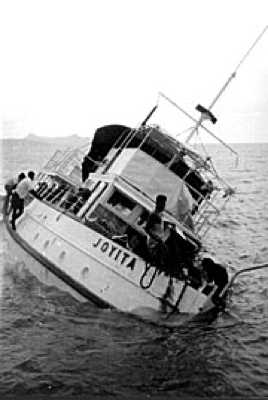
MV Joyita was an American merchant vessel from which 25 passengers and crew mysteriously disappeared in the South Pacific in October 1955. She was found adrift with no one aboard.

Capsizing or keeling over occurs when a boat or ship is rolled on its side or further by wave action, instability or wind force beyond the angle of positive static stability or it is upside down in the water. The act of recovering a vessel from a capsize is called righting. Capsize may result from broaching, knockdown, loss of stability due to cargo shifting or flooding, or in high speed boats, from turning too fast.

A ship is scuttled when its crew deliberately sinks it, typically by deliberately opening holes in its hull.
Ballast is used in ships to provide moment to resist the lateral forces on the hull. Insufficiently ballasted boats tend to tip or heel excessively in high winds. Too much heel may result in the vessel capsizing. If a sailing vessel needs to voyage without cargo, then ballast of little or no value will be loaded to keep the vessel upright. Some or all of this ballast will then be discarded when cargo is loaded.

S-80 was a diesel-electric submarine of the Soviet Navy.

An escape trunk is a small compartment on a submarine which provides a means for crew to escape from a downed submarine; it operates on a principle similar to an airlock, in that it allows the transfer of persons or objects between two areas of different pressure.

Hydrolock is an abnormal condition of any device which is designed to compress a gas by mechanically restraining it; most commonly the reciprocating internal combustion engine, the case this article refers to unless otherwise noted. Hydrolock occurs when a volume of liquid greater than the volume of the cylinder at its minimum enters the cylinder. Since liquids are nearly incompressible the piston cannot complete its travel; either the engine must stop rotating or a mechanical failure must occur.

A ballast tank is a compartment within a boat, ship or other floating structure that holds water, which is used as ballast to provide hydrostatic stability for a vessel, to reduce or control buoyancy, as in a submarine, to correct trim or list, to provide a more even load distribution along the hull to reduce structural hogging or sagging stresses, or to increase draft, as in a semi-submersible vessel or platform, or a SWATH, to improve seakeeping. Using water in a tank provides easier weight adjustment than the stone or iron ballast used in older vessels, and makes it easy for the crew to reduce a vessel's draft when it enters shallower water, by temporarily pumping out ballast. Airships use ballast tanks mainly to control buoyancy and correct trim.

A Kingston valve is a type of valve fitted in the bottom of a ship's plating that connects the sea to the ship's piping and storage tanks.

SS Antilla was a Hamburg America Line (HAPAG) cargo ship that was launched in 1939 and scuttled in 1940.
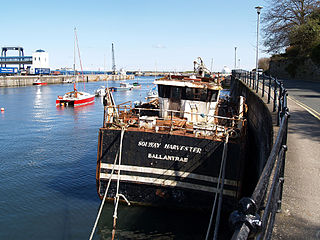
The Solway Harvester was a scallop dredger from Kirkcudbright, Scotland which sank off the coast of Douglas, Isle of Man in heavy seas on 11 January 2000 with the loss of all seven crew members. Following salvage, the damaged ship was taken to Douglas, where she remained until dismantled for scrap in January 2014.
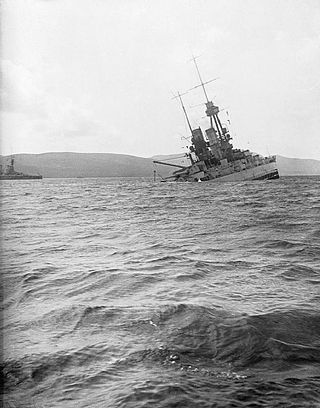
Shortly after the end of the First World War, the Imperial German Navy was scuttled by its sailors while held off the harbour of the British Royal Navy base at Scapa Flow, in the Orkney Islands of Scotland. The High Seas Fleet was interned there under the terms of the Armistice while negotiations took place over the fate of the ships. Fearing that either the British would seize the ships unilaterally or the German government at the time might reject the Treaty of Versailles and resume the war effort, Admiral Ludwig von Reuter decided to scuttle the fleet.
This glossary of nautical terms is an alphabetical listing of terms and expressions connected with ships, shipping, seamanship and navigation on water. Some remain current, while many date from the 17th to 19th centuries. The word nautical derives from the Latin nauticus, from Greek nautikos, from nautēs: "sailor", from naus: "ship".
